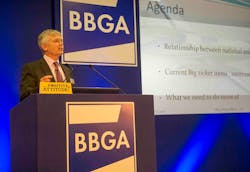Bolstered BBGA Adapts to new Landscape: Meets at Luton Hoo for 43rd Annual Meeting.
‘Embracing change’ was the theme of the British Business and General Aviation Association’s annual conference on March 9th, exploring the ways in which the industry today is not the same as it was five years ago – on a number of levels – in technology, the environment, and in politics. Ahead of the UK government triggering Article 50 on 29th March, Brexit was high on the agenda.
In his opening address at the new venue, Luton Hoo Hotel, BBGA Chairman Marwan Khalek highlighted the challenges the newly bolstered 174-member Association faces, among them airspace access, heightened regulation and the threatened closure of general aviation airports in favour of housing.
He noted some bright spots too. Not least is EASA finally granting approval for Single Engine Turboprops (SETops) to be cleared for public charter IFR (effective 22nd March).
SETops operations – which must be under an AOC and specifically cover relevant aircraft such as the Daher TBM800/900; Cessna Caravan and Pilatus PC-12 – have now been cleared in 32 EU countries. This a significant decision because it will help open up a new affordable entry level for business aviation..
The market is already seeing an uptick in traffic growth from UK airports to Europe of 3% according to the latest (February 2017) statistics from WINGX Advance – equivalent to 126 daily movements. Of the top 20 performing European business aviation airports, five are in the UK: Luton; Farnborough; London Biggin Hill; London Oxford and Northolt, in that order.
BBGA CEO Marc Bailey hailed the significance of the Association’s new partnership with EBAA, where existing UK EBAA members automatically become members of BBGA while new EBAA members join via BBGA.
Guest speaker Chris Leach, founder and chairman of charter brokerage Air Charter Service (ACS), highlighted in his address the importance of having good people. Invest in their training so they become ambassadors for you, he said. You have to be willing to start with zero productivity before you let them talk to clients – never assume they have all the necessary skills already. Leach attributes ACS’ success (they’ve been in business since 1990 and now have a 350-strong team globally) to adapting to market change and having diversity of revenue – ACS’s top 10 clients account for less than 15% of the company’s overall income, he said.
Martin Rolfe, CEO of NATS, emphasised that changes in airspace are now critical to handle increased traffic growth from the UK and to meet the demands of new smaller aircraft coming in. The UK and London in particular, is a buoyant market, accounting for 78,000 movements in 2016. Trumpeting local control of regulations, the current five-year terms implemented by the Government don’t allow for the flexibility the industry requires to progress with airspace change, he said.
On the Brexit panel alongside UK CAA’s Andrew Haines and Clyde and Co’s Mark Bisset, Sir Gerald Howarth, MP for Aldershot, said Britain’s aviation industry is in a strong position, with 40% of US–EU traffic coming into the UK. You have the chance to be vocal ahead of Brexit so speak up, he said. Haines wants to make it so that there will be no change to European legislation until we leave the EU, but noted the political nature of Brexit meant there could be no meaningful assurances about how things could turn out.
In a change from previous formats, there was an engaging presentation on the Association itself and where it should be heading from behaviour specialists Sewell’s. Since December, they have been conducting research on what both members and non-members think of BBGA and how they can better serve membership in the future with a new set of Visions and Values. From their initial feedback, it’s clear the Association is appreciated by the industry, but if it is to flourish as business aviation’s biggest national association, it will need more resources, delegates heard.
Chaired by Alex Berry, a panel discussion in the afternoon looked at the new/disruptor markets. Simon Talling-Smith, CEO of Surf Air, which will bring its popular US airline subscription model to Europe in the next few months, asserted that 85% of its 3,000 members in California came over from commercial airlines. He said he never expected the company to be enjoying a partnership with Lufthansa Miles and More. When it debuts in Europe (under TAG’s AOC), Surf Air is targeting 5% of the European short-haul market that will pay more for a better service where there is now little difference in the product offering between British Airways and the low-cost carriers, he asserted.
Refuting a suggestion from the audience that the disruptor model is coming about purely for the sake of growth, Carol Cork, Co-Founder and Director of Sales & Marketing for PrivateFly, said it’s certainly not the beginning of a race to the bottom. Instead of entering a price war with commercial airlines, the key is to show corporate travellers the convenience (and affordability) business aviation can deliver.
Oriens Aviation CEO, Edwin Brenninkmeyer, who sits on the board of Linear Air in the US alongside his role as UK sales distributor for the Pilatus PC-12, said Linear was attracting customers from commercial airlines through an innovative partnership with digital sales platform, KAYAK.
EBAA President Brian Humphries said the more people learned about business aviation, the more positive they appeared to be about the industry. He urged members to be more vocal about what they do, and in turn help the EBAA’s own multi-million Euro Face to Face five-year perception campaign, which was unveiled in Brussels at its 40th agm last week.





